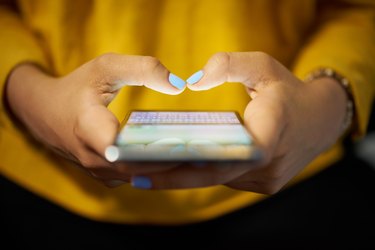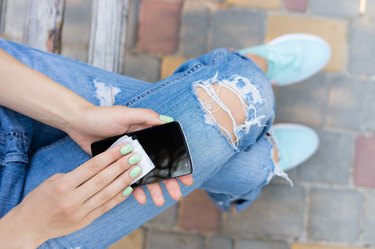
If you're like most people, your smartphone is practically an extension of your hand. In fact, the average American checks his or her phone about once every 10 minutes — for a total of 96 times a day, according to November 2019 research by global tech protection company Asurion.
All that checking adds up to a lot of touching. But your phone isn't the only thing your hands are holding. From bathroom doorknobs to grocery carts to subway poles, your fingers come across a lot of dirty objects. And, odds are, the slew of germs you've encountered during the day will end up clinging to your trusty mobile.
Video of the Day
Video of the Day
Whether you're taking precautions to prevent catching the coronavirus or just trying to avoid the common cold, here's what you should know about the pesky pathogens lurking on your tech and how to disinfect your phone.
Get tips on how to stay healthy, safe and sane during the novel coronavirus pandemic.
How Germy Are Our Phones?
Simply put: "They are dirty," says Jason Kindrachuk, PhD, a virologist at the University of Manitoba in Canada.
Think about it: Do you wash your hands before using your phone? Probably not.
Not only are we transmitting germs to our phones with our grubby fingers, but we're also haphazardly placing our mobile devices on surfaces that may be unclean, Kindrachuk says.
Case in point: Researchers found that one in six cell phones is contaminated with fecal matter, according to a 2011 study by the London School of Hygiene & Tropical Medicine. What's more, 16 percent of phones tested harbored harmful E. coli bacteria.
Perhaps even more alarming is a July 2015 study in Advanced Biomedical Research that found almost 82 percent of healthcare workers' phones showed growth of bacterial pathogens (including staphylococcus and E. coli), indicating that mobile devices may be a potential source of infections in hospital settings.

How to Disinfect Your Phone
Cleaning your phone is good practice. "Soap and water is by far and away the best anti-infective product we have," says Kindrachuk, adding that liquid dishwashing soaps work well.
Of course, water is a hazard for most smartphones, so you may want to opt instead for alcohol wipes.
While obviously convenient, disinfecting wipes have some drawbacks to keep in mind, Kindrachuk says. Depending on the type, they may not kill all pathogens that can be lurking on your phone. Plus, the presence of oils or other materials on a soiled surface can affect the antimicrobial activities of disinfectant wipes, he says. That's because oils make it harder for "the product to penetrate to the microbes at the concentration required for inactivation of the germs," he explains.
5 Steps to Disinfect Your Phone
- Wipe away oils first: Use a soft, lint-free cloth to wipe down the hard surfaces of the phone and remove dirt and oils. This will pave the way so the disinfecting wipe can better do its job.
- Choose the right alcohol wipe: According to Apple, you should select a wipe that is 70 percent isopropyl alcohol (check the ingredients on the back of the package). Apple recommends Clorox Disinfecting Wipes. Do not use bleach.
- Remove the case: If your phone case is made of fabric or leather, you'll want to remove it to prevent possible damage from the alcohol wipe.
- Wipe gently: Wipe the hard, nonporous surfaces of your phone, including the screen.
- Avoid openings: Avoid getting moisture into any of the phone's openings, such as the speakers or charging port.
Worth noting: Kindrachuk isn't a huge fan of products like PhoneSoap, which uses UV light to disinfect your mobile device. "These are problematic, as the rate of inactivation of germs depends on both the distance between the light and the surface as well as the age of the lamp (it's effectiveness decreases with age)," he says.
So, how often should you sanitize your smartphone? "The rule of thumb is simple: Clean it more than you already do,"Kindrachuk says.
Tip
The Centers for Disease Control and Prevention recommend cleaning all high-touch surfaces every day, including your phone as well as keyboards and tablets.
Can Your Phone Make You Sick?
In theory, yes. "From all of the data that has been collected, the potential for infection exists since the types of germs that can make someone sick are present," Kindrachuk says.
And when it comes to the novel coronavirus, a March 2020 study in The New England Journal of Medicine found that the virus can live on plastic and stainless steel surfaces for up to three days.
But it's not so cut and dry.
"The question is how readily these germs can get to where they need to cause an infection," he says. In other words, places of vulnerability like cuts and abrasions or mucous membranes in the nose or mouth. So, if you have a scrape or a hangnail where the microbe can enter, or if you transmit the germs by touching your face, you have a greater likelihood of becoming infected.
Tip
Stop touching your face. Many germs enter our bodies through our eyes, nose and mouth, so keep your fingers away from these portals as much as possible to avoid passing on pathogens.
Plus, the lifespan of a pathogen (on a surface) varies wildly depending on whether it's classified as a bacteria or virus (and what type of bacteria or virus it is), Kindrachuk says. "Unfortunately, there are no specific timeframes that are universal, but given how resilient these pathogens are, it's a good bet that there will always be something there."
Concerned About COVID-19?
Read more stories to help you navigate the novel coronavirus pandemic:
- Asurion: "Americans Check Their Phones 96 Times a Day"
- London School of Hygiene & Tropical Medicine: “Contamination of UK mobile phones and hands revealed.”
- Advanced Biomedical Research: "Mobile phones: Reservoirs for the transmission of nosocomial pathogens."
- Centers for Disease Control and Prevention: "Preventing the Spread of Coronavirus Disease 2019 in Homes and Residential Communities"
- The New England Journal of Medicine: "Aerosol and Surface Stability of SARS-CoV-2 as Compared with SARS-CoV-1"
Is this an emergency? If you are experiencing serious medical symptoms, please see the National Library of Medicine’s list of signs you need emergency medical attention or call 911.